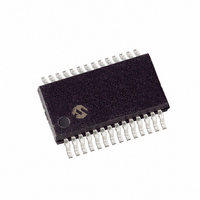PIC16F913-I/SS Microchip Technology, PIC16F913-I/SS Datasheet - Page 208

PIC16F913-I/SS
Manufacturer Part Number
PIC16F913-I/SS
Description
IC PIC MCU FLASH 4KX14 28SSOP
Manufacturer
Microchip Technology
Series
PIC® 16Fr
Datasheets
1.PIC16F616T-ISL.pdf
(8 pages)
2.PIC16F913-ISS.pdf
(330 pages)
3.PIC16F913-ISS.pdf
(8 pages)
4.PIC16F913-ISS.pdf
(34 pages)
Specifications of PIC16F913-I/SS
Core Size
8-Bit
Program Memory Size
7KB (4K x 14)
Core Processor
PIC
Speed
20MHz
Connectivity
I²C, SPI, UART/USART
Peripherals
Brown-out Detect/Reset, LCD, POR, PWM, WDT
Number Of I /o
24
Program Memory Type
FLASH
Eeprom Size
256 x 8
Ram Size
256 x 8
Voltage - Supply (vcc/vdd)
2 V ~ 5.5 V
Data Converters
A/D 5x10b
Oscillator Type
Internal
Operating Temperature
-40°C ~ 85°C
Package / Case
28-SSOP
Controller Family/series
PIC16F
No. Of I/o's
24
Eeprom Memory Size
256Byte
Ram Memory Size
256Byte
Cpu Speed
20MHz
No. Of Timers
3
Package
28SSOP
Device Core
PIC
Family Name
PIC16
Maximum Speed
20 MHz
Operating Supply Voltage
5 V
Data Bus Width
8 Bit
Number Of Programmable I/os
24
Interface Type
I2C/SPI/USART
On-chip Adc
5-chx10-bit
Number Of Timers
3
Processor Series
PIC16F
Core
PIC
Data Ram Size
352 B
Maximum Clock Frequency
20 MHz
Maximum Operating Temperature
+ 85 C
Mounting Style
SMD/SMT
3rd Party Development Tools
52715-96, 52716-328, 52717-734
Development Tools By Supplier
PG164130, DV164035, DV244005, DV164005, PG164120, ICE2000, DV164120
Minimum Operating Temperature
- 40 C
Lead Free Status / RoHS Status
Lead free / RoHS Compliant
For Use With
AC164307 - MODULE SKT FOR PM3 28SSOPXLT28SS-1 - SOCKET TRANSITION ICE 28SSOP
Lead Free Status / Rohs Status
Details
Available stocks
Company
Part Number
Manufacturer
Quantity
Price
Company:
Part Number:
PIC16F913-I/SS
Manufacturer:
INFINEON
Quantity:
201
Company:
Part Number:
PIC16F913-I/SS
Manufacturer:
Microchi
Quantity:
7 664
Part Number:
PIC16F913-I/SS
Manufacturer:
MIC
Quantity:
20 000
- PIC16F616T-ISL PDF datasheet
- PIC16F913-ISS PDF datasheet #2
- PIC16F913-ISS PDF datasheet #3
- PIC16F913-ISS PDF datasheet #4
- Current page: 208 of 330
- Download datasheet (7Mb)
PIC16F913/914/916/917/946
14.12.3
When the R/W bit of the incoming address byte is set
and an address match occurs, the R/W bit of the
SSPSTAT register is set. The received address is
loaded into the SSPBUF register. The ACK pulse will
be
RC6/TX/CK/SCK/SCL/SEG9 is held low. The transmit
data must be loaded into the SSPBUF register, which
also
RC6/TX/CK/SCK/SCL/SEG9 should be enabled by
setting bit CKP of the SSPCON register. The master
must monitor the SCL pin prior to asserting another
clock pulse. The slave devices may be holding off the
master by stretching the clock. The eight data bits are
shifted out on the falling edge of the SCL input. This
ensures that the SDA signal is valid during the SCL high
time (Figure 14-10).
FIGURE 14-10:
DS41250F-page 206
SDA
SCL
SSPIF (PIR1<3>)
BF (SSPSTAT<0>)
CKP (SSPCON<4>)
sent
loads
S
TRANSMISSION
on
the
A7
1
Data in
sampled
the
SSPSR
A6
2
I
2
C™ WAVEFORMS FOR TRANSMISSION (7-BIT ADDRESS)
A5
Receiving Address
3
ninth
A4
4
register.
A3
5
bit,
A2
6
Then,
A1
and
7
R/W = 1
8
pin
pin
9
ACK
responds to SSPIF
while CPU
SCL held low
An SSP interrupt is generated for each data transfer
byte. Flag bit SSPIF must be cleared in software, and
the SSPSTAT register is used to determine the status
of the byte. Flag bit SSPIF is set on the falling edge of
the ninth clock pulse.
As a slave-transmitter, the ACK pulse from the master
receiver is latched on the rising edge of the ninth SCL
input pulse. If the SDA line was high (not ACK), then
the data transfer is complete. When the ACK is latched
by the slave, the slave logic is reset (resets SSPSTAT
register) and the slave then monitors for another
occurrence of the Start bit. If the SDA line was low
(ACK), the transmit data must be loaded into the
SSPBUF register, which also loads the SSPSR
register. Then pin RC6/TX/CK/SCK/SCL/SEG9 should
be enabled by setting bit CKP.
D7
1
SSPBUF is written in software
D6
2
Cleared in software
Set bit after writing to SSPBUF
(the SSPBUF must be written to
before the CKP bit can be set)
D5
3
D4
4
Transmitting Data
D3
5
© 2007 Microchip Technology Inc.
D2
6
From SSP Interrupt
Service Routine
D1
7
D0
8
ACK
9
P
Related parts for PIC16F913-I/SS
Image
Part Number
Description
Manufacturer
Datasheet
Request
R

Part Number:
Description:
IC PIC MCU FLASH 4KX14 28SOIC
Manufacturer:
Microchip Technology
Datasheet:

Part Number:
Description:
IC PIC MCU FLASH 4KX14 28DIP
Manufacturer:
Microchip Technology
Datasheet:

Part Number:
Description:
IC PIC MCU FLASH 4KX14 28QFN
Manufacturer:
Microchip Technology
Datasheet:

Part Number:
Description:
IC PIC MCU FLASH 4KX14 28SOIC
Manufacturer:
Microchip Technology
Datasheet:

Part Number:
Description:
IC PIC MCU FLASH 4KX14 28DIP
Manufacturer:
Microchip Technology
Datasheet:

Part Number:
Description:
IC,MICROCONTROLLER,8-BIT,PIC CPU,CMOS,LLCC,28PIN,PLASTIC
Manufacturer:
Microchip Technology
Datasheet:

Part Number:
Description:
IC,MICROCONTROLLER,8-BIT,PIC CPU,CMOS,SSOP,28PIN,PLASTIC
Manufacturer:
Microchip Technology
Datasheet:

Part Number:
Description:
(PIC16F913 - PIC16F917) 8-Bit CMOS Microcontrollers
Manufacturer:
Microchip Technology

Part Number:
Description:
IC, 8BIT MCU, PIC16F, 32MHZ, SOIC-18
Manufacturer:
Microchip Technology
Datasheet:

Part Number:
Description:
IC, 8BIT MCU, PIC16F, 32MHZ, SSOP-20
Manufacturer:
Microchip Technology
Datasheet:

Part Number:
Description:
IC, 8BIT MCU, PIC16F, 32MHZ, DIP-18
Manufacturer:
Microchip Technology
Datasheet:

Part Number:
Description:
IC, 8BIT MCU, PIC16F, 32MHZ, QFN-28
Manufacturer:
Microchip Technology
Datasheet:

Part Number:
Description:
IC, 8BIT MCU, PIC16F, 32MHZ, QFN-28
Manufacturer:
Microchip Technology
Datasheet:

Part Number:
Description:
IC, 8BIT MCU, PIC16F, 32MHZ, QFN-28
Manufacturer:
Microchip Technology
Datasheet:

Part Number:
Description:
IC, 8BIT MCU, PIC16F, 32MHZ, SSOP-20
Manufacturer:
Microchip Technology
Datasheet:











